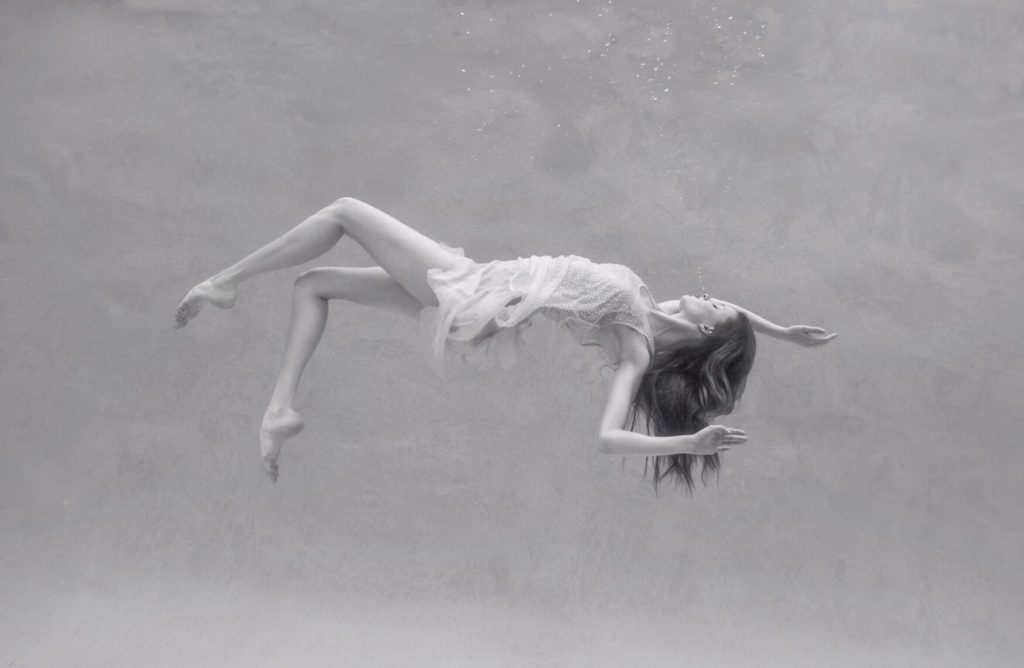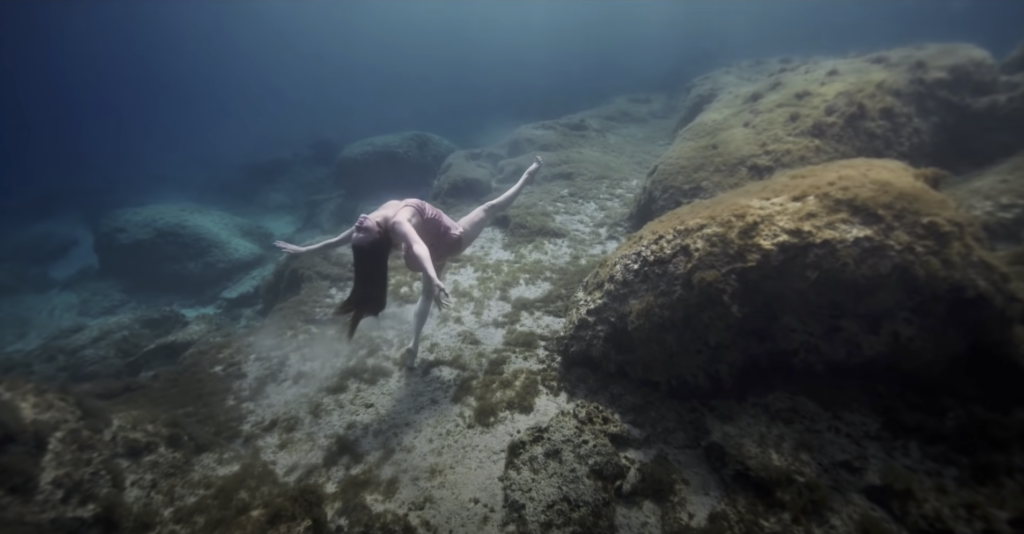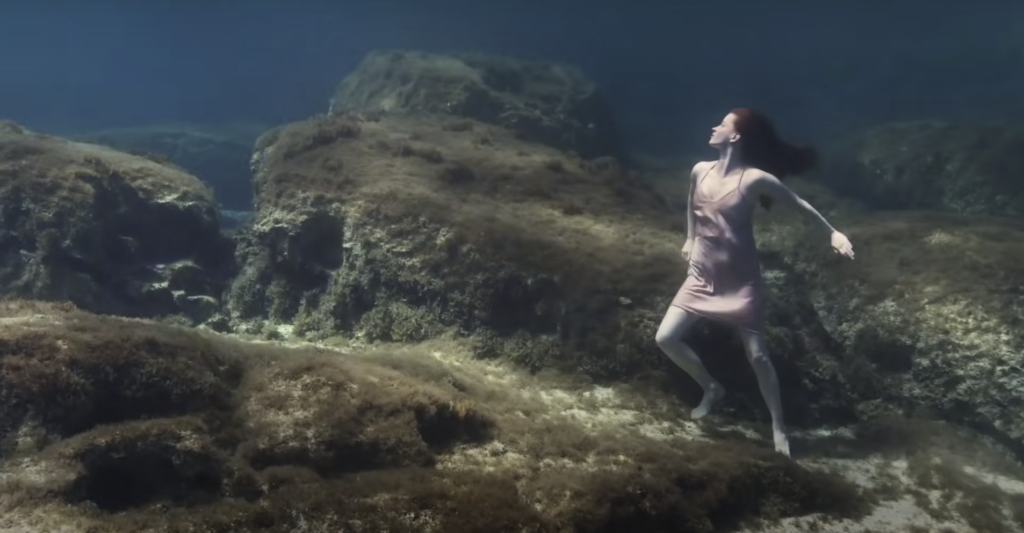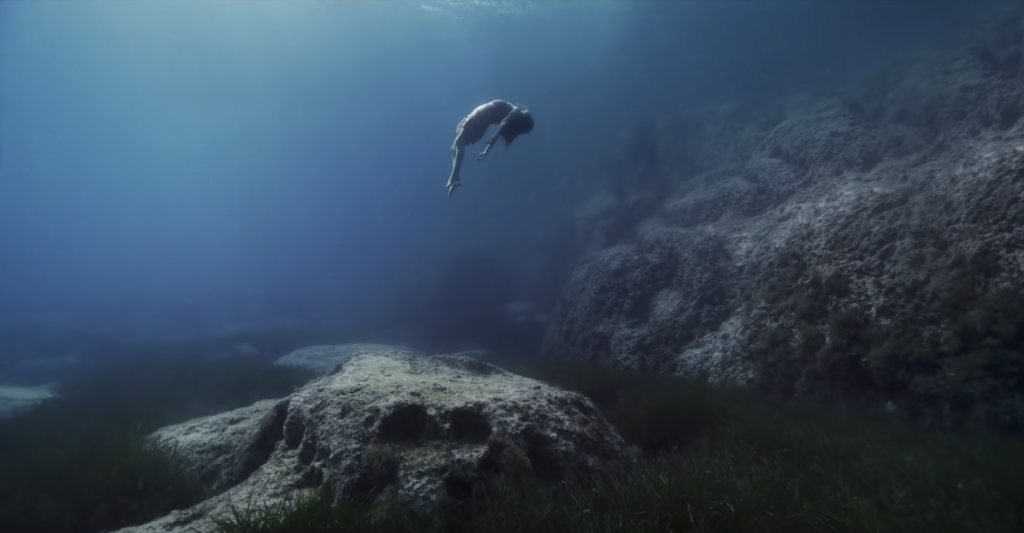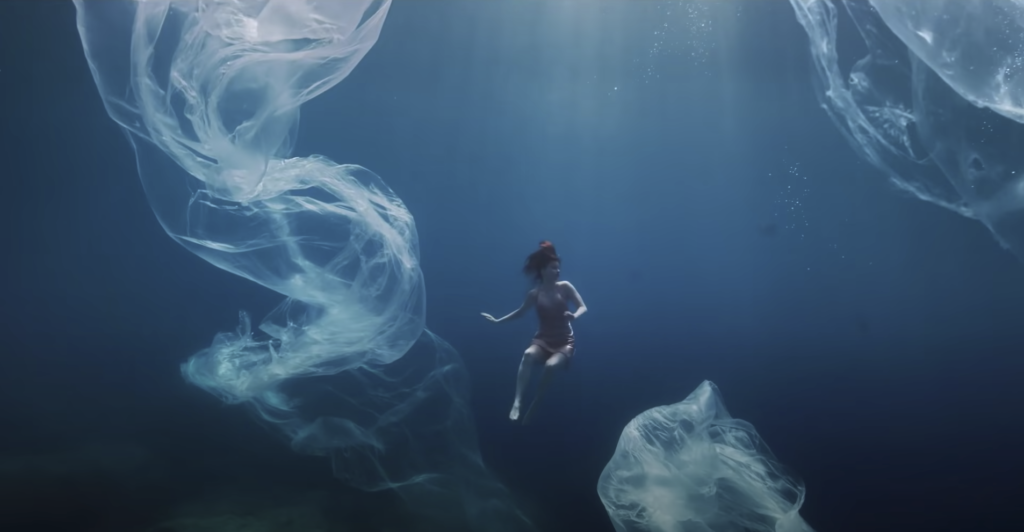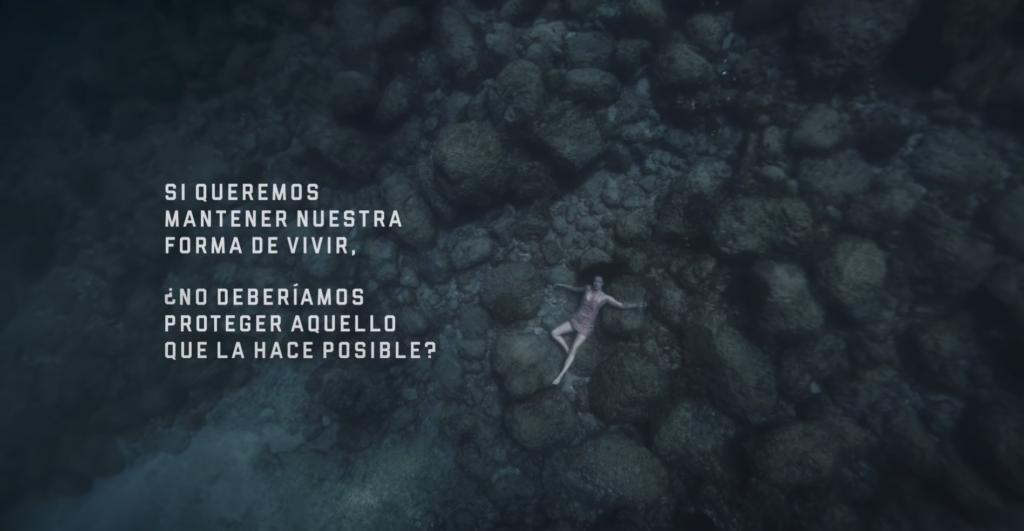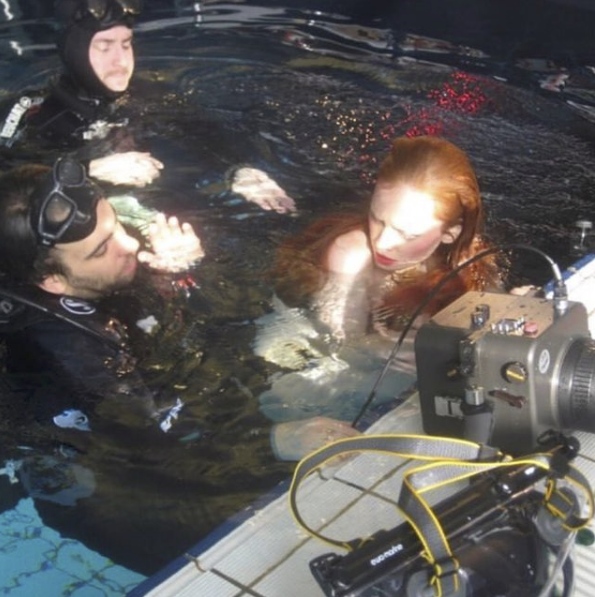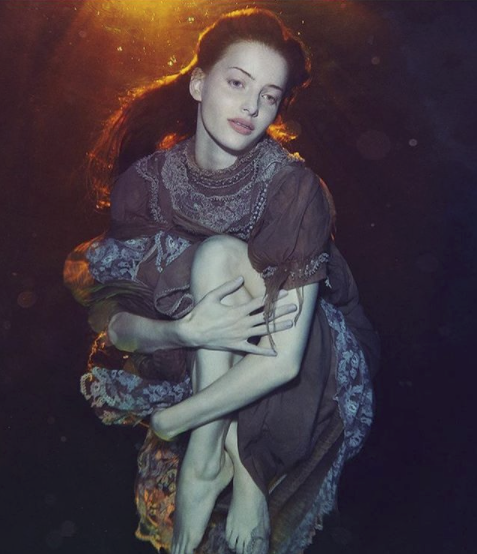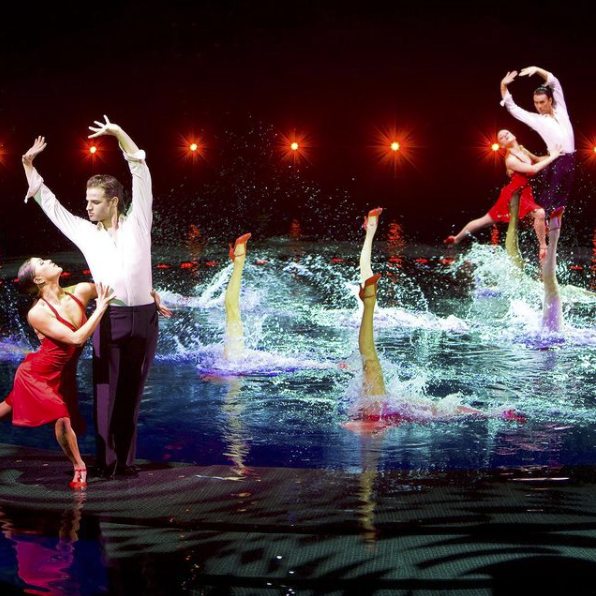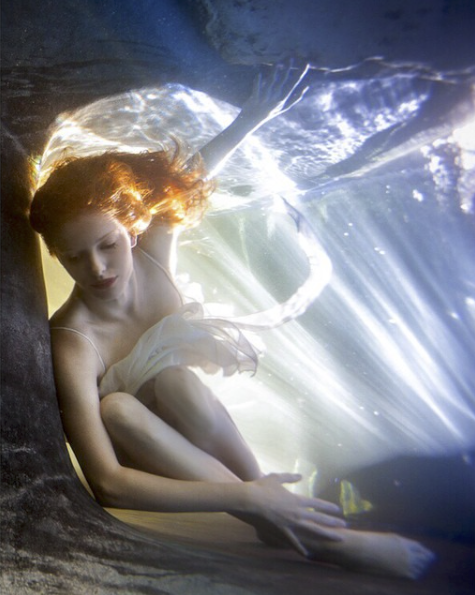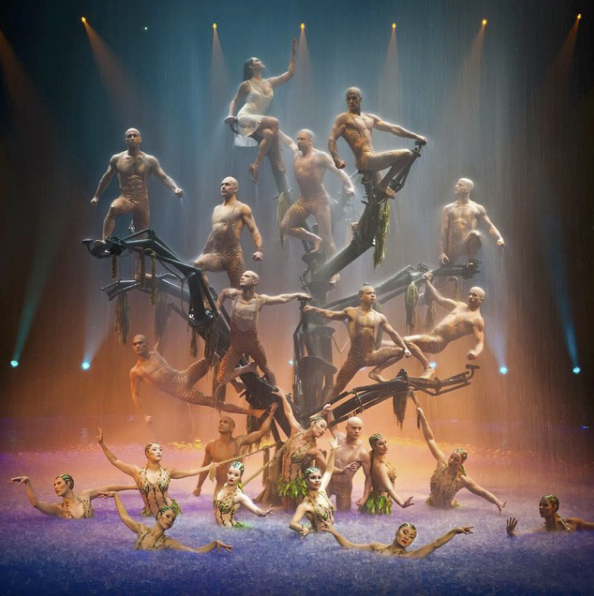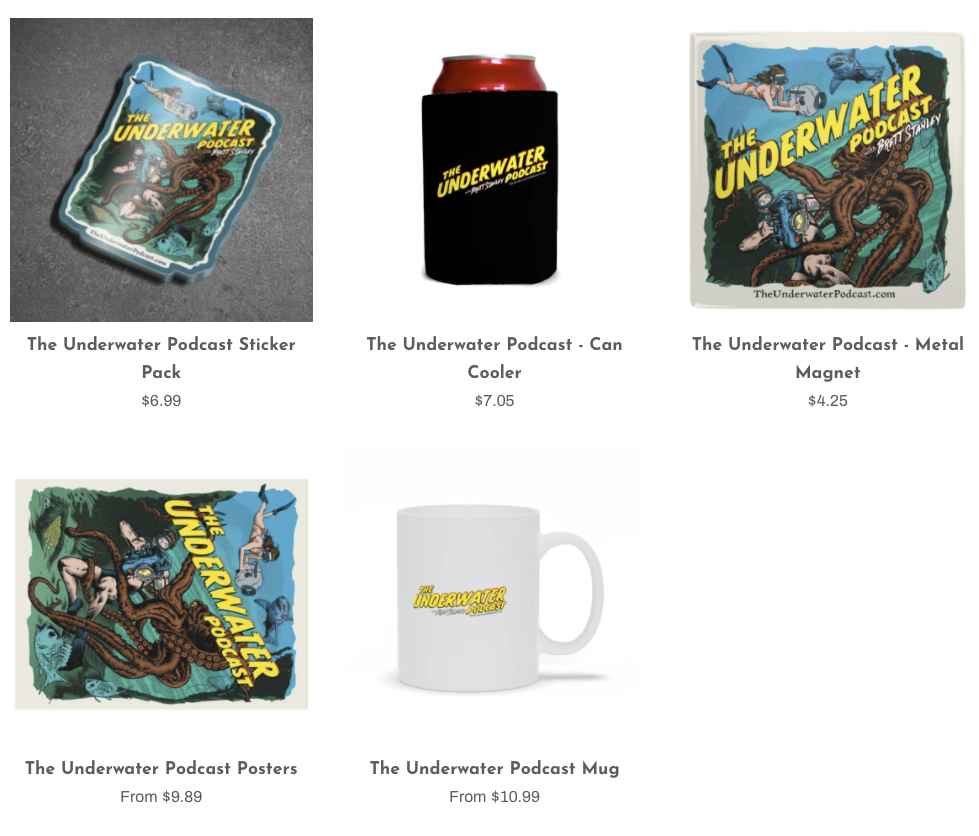Performer Claire Friesen
In episode #40, host Brett Stanley chats with underwater performer and actor Claire Friesen. Claire grew up fascinated with water, and solidified her love it with it when she discovered synchronized swimming. After competing on the Canadian National Team, she moved to Las Vegas to start her dream job of performing in the aquatic Cirque show Le Rêve – a mind bending extravaganza of aerial and underwater performance.
They chat about her work in TV, film, commercials, and how freediving helps to keep her in tune with her surroundings.
Follow them: Website, Instagram
Discuss the episode in our facebook group.
About Underwater Performer & Actor Claire Friesen
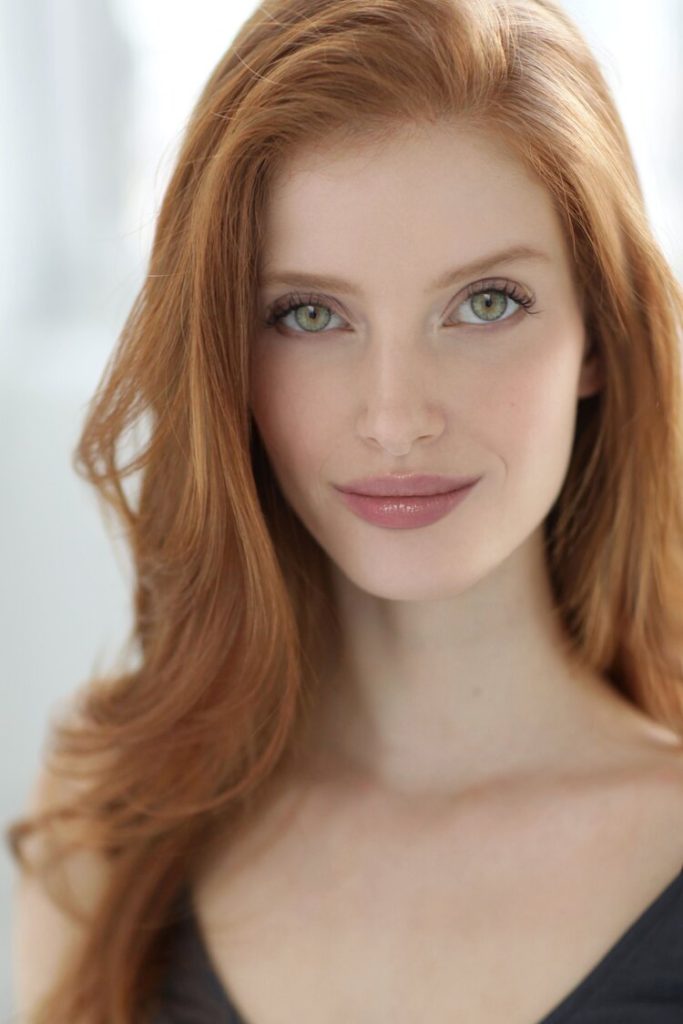
I grew up in the Canadian Rocky Mountains and was a member of the Canadian National Synchronized Swimming Team. I began my performance career as Captain, Soloist and Character in Franco Dragone’s aquatic Cirque du Soleil show Le Rêve. Discovering my passion for acting, I moved to New York City to train at the esteemed William Esper Studio. Since then, notable theatre credits include the NYC International Fringe Festival, Manhattan Repertory Theatre, and The Roebuck Theater. Television credits include The Marvelous Mrs. Maisel (Amazon), Jane the Virgin (The CW), and Claws (TNT). National commercials include Bud Light, DirecTV, JBL Audio, Madewell, Specialized, Lancia, and Estrella Damm. I’ve been featured in The NY Times, Broadway World, Huffington Post, cover of Playboy, InStyle, Harper’s Bazaar, and Vogue Italia.
Most recently, I was the lead talent on Lake of Dreams (Dir. Kenny Ortega). I also just wrapped filming sci-fi film U.S.O. with NION Tokyo (Dir. Mackenzie Sheppard).
Outside of the arts, I am passionate about bringing awareness to ocean conservation, reducing single-use plastic, and living more sustainably. If you’d like to join me, please visit: www.no2plastic.org/ambassadors/claire-friesen.
Podcast Transcript
Ep 40 – Claire Friesen
Brett Stanley: [00:00:00] Welcome back to the underwater podcast. And this week we’re traipsing the light. Fantastic. With underwater performer, Claire Friesen. Claire grew up fascinated with water and solidified her love of it with synchronized swimming in her teens. She moved from Canada to Las Vegas to start her dream job of working on the water-based Cirque du Soleil show La Reve a mind bending extravaganza of aerial and underwater performance. We chat about her work in TV and commercials and how freediving helps her keep in tune with her surroundings. Okay. Let’s dive in.
Claire welcome to the underwater podcast.
Claire Friesen: [00:00:35] hi, Brett thank you so much for having me. I’m happy to be here.
Brett Stanley: [00:00:39] Yeah, it’s great to have you here. Where are you at the moment? Are you you’re in Canada, right?
Claire Friesen: [00:00:43] I am. I am. I’ve. I’ve been based in New York city for the last few years, but because of COVID I recently moved to Vancouver so I could keep working. So I’m, I’m feeling very lucky to be back in Canada, grateful to be able to spend more time with my family. And, and I’m also really looking forward to meeting people in the free diving underwater community here.
Cause it seems pretty robust.
Brett Stanley: [00:01:05] yeah, it does. I mean, I’ve kind of spoken to a few people up there. And I think if you don’t mind the cold
Claire Friesen: [00:01:11] right?
Brett Stanley: [00:01:11] pretty good.
Claire Friesen: [00:01:12] Yes. I haven’t had a lot of time in the water in these temperatures, but it’s definitely a new challenge.
Brett Stanley: [00:01:20] Have you done a lot of open water stuff?
Claire Friesen: [00:01:22] and a few projects in the ocean. Yes. And those are my favorite because you really get to feel the experience of, of being underwater and, and in these like amazing, magical places, it’s like, you’re privy to this secret world. So I love those shoots for sure. And where are you? Are you you’re in California.
Brett Stanley: [00:01:44] Yeah. Yeah. I’m in Los Angeles, so it’s a little warmer down here, but but yeah, the water here is probably. High sixties on a good day.
Claire Friesen: [00:01:51] Okay. Okay.
Brett Stanley: [00:01:53] I’m I can’t remember what that is in Celsius, but like 15 degrees.
Claire Friesen: [00:01:56] That’s still cold.
Brett Stanley: [00:01:58] Yeah. Yeah. It’s definitely. It’s it wakes you up. You feel alive.
Claire Friesen: [00:02:03] Exactly. Exactly.
Brett Stanley: [00:02:05] What sort of open water projects have you done?
I did see you did a commercial. Is it for, for a beer brand?
Claire Friesen: [00:02:11] Yes. Yes. That was, I think the one you’re referring to it was for Australia dam and that one we filmed off the coast of Cyprus. It was, I mean, it was an incredible experience. The team was amazing. The whole project was to raise awareness. About like the effects of single use plastic on the Mediterranean ocean.
And it just received the most overwhelming response. So it was a pretty special project, like amazing underwater team. Jack led it with his team, Amy Gardner choreographed, and everything was shot in camera. There was no special effects done in post. So all of the plastic that you see. That’s amazing FX team somehow managed to position it in the ocean while it was moving.
And
Brett Stanley: [00:02:58] That’s great cause that, that, that short film, which it kind of is, you know, this commercial is, you know, it’s got you kind of dancing and performing under the water and in Europe, it’s, it’s fairly deep to, it probably looks like it’s at least 20, 20 feet down.
Claire Friesen: [00:03:13] yeah. I think the deepest part we shot in was about 12 meters. So it was, yeah, it was amazing. It was, it was pretty cool.
Brett Stanley: [00:03:22] So what sort of support did you have on that? what was the process of filming that?
Claire Friesen: [00:03:26] Yeah, so we, we had an underwater safety team. I did the whole shoot. I was just free diving. There was no scuba, but it was, it was there, you know, in case we needed it. And then we had the effects team and then we had a whole crew on land. You know, obviously watching through video, and the director going with sometimes.
Come down on school, van watch from underwater, which was pretty cool. He was like, it’s a, it’s an very different show under here.
Brett Stanley: [00:03:52] Give him a pension. Yeah. So, so you weren’t like you weren’t staged out off the coast. You were actually on, on the shore and it was just a, a deeper part of the shore.
Claire Friesen: [00:04:00] I don’t know, maybe like a hundred meters off the coast. So we weren’t w we were, we were very close. But we were set up on, on boats and, and whatnot,
Brett Stanley: [00:04:10] right. Yeah. And did you, did you say that you weren’t using the scuba, so you were just doing it all on freedive just breath.
Claire Friesen: [00:04:16] Yes.
Brett Stanley: [00:04:17] Wow. So what sort of breath hold have you got? It must be fairly decent.
Claire Friesen: [00:04:21] I I’m not exactly sure. The last time I checked it was about four minutes, but I mean, it changes when you’re, especially for this project you’re dancing. So you’re exerting a lot more energy than you would when you’re just free diving and in a totally relaxed state. So, you know, you’re, and especially with the moderate temperatures and not at all changes, but I think about format.
Brett Stanley: [00:04:44] That’s pretty good. I mean, to give you a, at least a couple of minutes worth of footage too, like per take. Yeah.
Claire Friesen: [00:04:51] Yeah. Especially if you’re having to go that far down by the time you, you know, you sat in camera’s ready, everything, you know, you need some time
Brett Stanley: [00:04:58] yeah. So how were you getting down? Were you just getting down under your own steam or were they such, did you have weights or anything?
Claire Friesen: [00:05:04] I, I did have a support diver who helped me down. And I also had a Kind of a rope to help me guide me down to the right position. And so the first part was weighted. I would kind of hold onto a weight and drop maybe three or four meters and then swim down the rest as I was equalizing.
Brett Stanley: [00:05:21] what was the decision to, to not put you on a regulator?
Claire Friesen: [00:05:24] I think it was, it was pretty just natural. We all felt comfortable with it and it’s. There’s something really freeing when you don’t have those breathing apparatuses on you really feel connected to the water? I think that’s my favorite part is really, you know, I feel at home and you get to that place where your body has just completely given over.
And there’s like a, you know, this peaceful calmness and you just feel like you can stay there forever. Especially when you’re out in the ocean, there’s just something really magical about, about that.
Brett Stanley: [00:05:55] I feel, I totally agree with you, Anna. I think, you know, I love scuba diving, but I love free diving kind of more because you it’s so much more quiet, you know, like you don’t have the bubbles, you don’t have the regulator noise. You do seem more at one. With the environment. Whereas the scuba for me kind of feels like you’re a little removed, cause you’re in your own little, I guess you’re in a little bubble, right?
Claire Friesen: [00:06:18] Yeah, no, exactly. I completely agree with you. I mean, it feels like time stops. And for me it, especially when I’m free diving or when I’m, you know, dancing purely for myself it really feels like a deep meditative state that you’re in you, you completely get out of your head. And, and like you said, everything is quiet.
It’s silent, except for, you know, the sound of your own heartbeat, which is. Really powerful.
Brett Stanley: [00:06:45] Yeah. Do you find that with free diving, having that, that, you know, set time limit of the breath hold makes you appreciate it more because you know, you’ve only got a certain number of minutes down here.
Claire Friesen: [00:06:57] That’s a good question, I guess. Yes and no. I, I don’t think, I think about the time so much when I’m underwater. I’m often surprised about how long it’s been. So I, I don’t, I don’t think I really think about it, but I mean, it does make you really appreciate, you know, this, you have such a short time to experience this world and you really want to soak it in and just be in awe of the beauty that’s there.
Yeah, I think that’s what I kind of mean is that it’s not so much, you’re looking at the watch, but you kind of, you know, you, you know, you’ve got a limited time, kind of make the most of it you know scuba diving, you kind of, it’s, it’s a lot more relaxed. It’s a lot more, you know, you’ve got at least half an hour, 45 minutes,
Yes. Yes, absolutely.
Brett Stanley: [00:07:43] it, it, it, I know like the experience is kind of a little bit watered down, I guess, you know, because it’s not, you know, you’ve got these, you know, if you’ve got a breath hold of two minutes, it’s everything’s, everything is pushed into those two minutes.
Claire Friesen: [00:07:55] Yes. No, absolutely. Absolutely. You want to get down there quick and be there?
Brett Stanley: [00:08:00] I really think, and I’ve said this before on the show, like for me, free diving kind of feels like a superpower. Like, it feels like this amazing gift that we’ve been given to be able to do this. And, and I think when you can get to that point where you are, your breath hold is it doesn’t have to be long, but it’s so surprising to you that you’re like, I’m still down here.
I still feel comfortable. What is this all about? You know,
Claire Friesen: [00:08:25] No, absolutely. I mean, I’m in all of these free divers that can stay underwater for, you know, 10, 12 minutes. It’s insane to me. I’m, I’m blown away, but it must be such a magical feeling to be able to spend that much time at once underwater. Yeah.
Brett Stanley: [00:08:42] Oh, absolutely. Yeah. And I, I wonder what that feels like that long, you know, cause for me, I think my breath hold is about two minutes like on a good day. And it always feels longer than two minutes. You know, it always like time slows down while I’m down there and imagine being, you know, eight, nine minutes worth how long that must feel to you and how, how much experience you can have.
Claire Friesen: [00:09:02] How deep they can go to, I mean, it’s, it’s like this unexplored territory down there.
Brett Stanley: [00:09:08] Yeah. Does, does the depth interest you going deeper?
Claire Friesen: [00:09:11] It does. It does. I mean, I think. As humans, we have a fascination with the unknown much like outer space underwater is this unexplored world. And so any time we’re able to spend down there, is really special.
Brett Stanley: [00:09:27] Do you think he’d ever go to spice?
Claire Friesen: [00:09:29] I, on my, I would love, yes. Yes. If there was an opportunity to go into space, hands down, I would go,
Brett Stanley: [00:09:36] That’s amazing. Yeah. Good. This is some people that I speak to who are like absolutely. I would totally go. And there’s other people who were like, God, no. Why would I do that? You know, but I’m then I’m like, you know, but you go, you almost go to space every time you go diving. And they’re like, it’s totally different.
It’s totally different. It’s such an interesting mindset change.
Claire Friesen: [00:09:52] Well, there’s so much underwater to explore that, you know, it’s in our own backyard. It’s amazing to me how much we don’t know about it yet. You know, there’s so much focus on outer space. But we can learn so much. I think about our planet from underwater.
Brett Stanley: [00:10:08] And it is almost less accessible than space. The an underwater is kind of, you know, it is more challenging than going to space because of the pressure because of the difficulties with it all, you know, it’s, it’s, it is kind of the final frontier.
Claire Friesen: [00:10:23] Yes. Yes. So I, hopefully we can make more progress in that during our lifetime and, and, you know, understand more about what happens down there. My twin sister is actually a Marine biologist, so I, I learned things from her. And then, you know, just in awe of this world,
Brett Stanley: [00:10:42] That’s amazing. So is she your identical twin?
Claire Friesen: [00:10:45] We are fraternal. We look more like sisters. But yeah, she does incredible work. She has the craziest stories about, you know, being in trash cans with octopus, trying to like free them into the ocean, or she’s done projects working in Antarctica and all over the world. So, yeah, it’s pretty amazing.
Brett Stanley: [00:11:04] So, how did you get into underwater? Was it something that you and both of you kind of loved as a kid? Or was it something you got into and.
Claire Friesen: [00:11:12] Yeah, no, absolutely. So we actually grew up in the middle East in Doha, Qatar, which is a tiny little peninsula that juts into the Persian Gulf. And my family moved there when my twin and I were one year old. And that’s really where my love for the world. Our love, I should say, definitely began. You know, it’s, it’s so hot and dry.
We spend as much time as we could in the pool and in the ocean. And I remember watching the Olympics on TV when I was. Six and seeing synchronized swimming for the first time and immediately telling my mom that I wanted to do this. And I made her take us to the pool. It was after midnight, we were in the middle of the night, swimming around in the dark, trying terribly to do these moves that we’d seen.
And so when we moved back to Canada a year later we were hooked already and that was it. So.
Brett Stanley: [00:12:04] Amazing. So you’d seen these synchronized script swimmers on screen. And then, and then, and you just want it to be them. You want it to do that?
Claire Friesen: [00:12:12] Yeah. I was so intrigued. I mean, I love the water and I love to dance. I was taking ballet and I was like, This is everything. This is all that I’ve imagined. And so, I mean that midnight swim led to over a decade of competition. So I really found a calling in that sport. Okay.
Brett Stanley: [00:12:31] Yeah. And so how did you get into that? Was, was synchronized swimming, something that was big in Doha.
Claire Friesen: [00:12:36] It wasn’t at all. So I, you know, it kind of. Stayed in the back of my mind for a year. And then we moved back to Canada. And so once we were back, we did a synchronized swimming summer camp and we’re like, yes, this is, this is what I want to do.
Brett Stanley: [00:12:51] yeah. So what was that like getting into there? Had you done any competitive, competitive swimming or anything beforehand, or was this your first real kind of competitive underwater?
Claire Friesen: [00:12:59] this was my first competitive, I guess, aquatic, adventure. I loved the water and was always swimming, but I’d never competed in, you know, speed swimming or in any other sport. But you know, I competed for 10 years in synchronized swimming and. You know, this culminated and competing on Canada’s national team, which was an incredible honor to represent my country and, you know, do what I love.
So I’m very honored to have been able to do that.
Brett Stanley: [00:13:28] And so where did you go from there? So once you’ve done the synchronized swimming, what did that lead you into?
Claire Friesen: [00:13:34] yeah. So after a few years competing on the national team, I had the opportunity to join the cast of Loretta and Loretta is a. This incredible aquatic Cirque display show in Las Vegas created by . And unfortunately the show just permanently closed after running for 15 years with COVID, but it was, it was, I don’t know if he ever had a chance to see it, but it was the most gorgeous show and holds a very special place in my heart.
I mean, I can’t even begin to explain the impact that the show had on me.
Brett Stanley: [00:14:08] Yeah, I did. I haven’t seen that one. I did see. Oh.
Claire Friesen: [00:14:12] Yes. Yes.
Brett Stanley: [00:14:13] it blew my mind,
Claire Friesen: [00:14:14] It’s the same director. So it’s very similar. Yes.
Brett Stanley: [00:14:18] So, so talk us through the rev. And what does that, what does that entail? I know it’s a, it’s a show Cirque de Solei show based on water, but, but give us more details on that.
Claire Friesen: [00:14:27] Let’s see where to begin. I mean, it was it’s, it’s this incredible or in the round, it’s an aquatic show. There’s a million gallon tank that we perform in there’s about 90 cast members from 17, 18 different countries with, you know, Various skill sets and languages and backgrounds all coming together to create this, this transformative experience.
You know, there’s, there’s synchronized swimmers like myself. There’s aerialists, there’s acrobats, there’s clowns. There’s, you know, there’s everything. It’s, it’s incredible. And I, I mean, I joined the show. I was the youngest cast member and this was my first show. So I had absolutely no idea what I was doing.
But these artists really welcomed me like family and I, I mean, I can’t, I can’t thank them enough. It was, it was incredible. We performed 10 shows a week, two shows a night, five nights a week, and each night we would perform a different track. So the lineup would be posted an hour before the first show.
And then we would find out, you know, what we were doing that night, which really helped keep it fresh when you’re doing thousands of the same show, it, you know, it can feel repetitive. So this is one way to really keep it exciting. There was an act called tango that was one of the main synchronized swimming acts.
And we performed in these now I conic red stilettos, which had to be repainted every night after the shows. I learned aerials and performed 50 feet up in the air without safety harnesses only, you know, being held by a blindfolded partner. It was, I mean, it was crazy. It really pushed me out of my comfort zone there.
Brett Stanley: [00:16:10] I can imagine, but I mean, if it’s anything like the production, you know, it is, like it’s a spectacle, like it is, it’s almost like you’re tripping. Like it’s, it’s kind of hallucinogenic.
Claire Friesen: [00:16:22] it, it is there’s, it’s almost overstimulating. There’s things going on all around you, you know, underwater on land in the air. There’s the show had fountains and fire and live birds. You know, there is everything that you could imagine. So you’re right. It really is a spectacle.
Brett Stanley: [00:16:41] And D w was it the same where the stage could actually rise up and become a dry stage and then disappear back down again?
Claire Friesen: [00:16:48] Yeah, there were a few different stages and so they could all move independently. Some could, you know, go under water. The tank was about, I believe, 27 feet deep. So it could go down to the bottom. It can go up. Maybe, I don’t know, 15 feet into the air. There was all different platforms. Like everything could move and rotate.
Yeah, it was a lot going on.
Brett Stanley: [00:17:11] That’s so impressive.
Claire Friesen: [00:17:13] There’s these underwater tunnels that we would make entrances through. So they were about 10 meters long that we would swim under a Nate who, because in them like regulators. So if you needed to breathe, you could, but it was, yeah, it was a pretty cool experience.
Brett Stanley: [00:17:28] Well, that’s what I was going to ask actually is what was it, what was happening under the water? Cause I, I think I’ve seen some behind the scenes stuff and it’s, you know, and they have a whole team of divers down there for the, for the thing. And what surprised me, especially with, Oh, was how many people would come out of the water at one time.
Claire Friesen: [00:17:44] Yes.
Brett Stanley: [00:17:45] Academy performance. They were down there and you kind of like, hang on, there’s gotta be at least a diver for every one of these people.
Claire Friesen: [00:17:51] Yes. Well, our show had 16 safety, divers underwater, and they, you know, had the ability to communicate to each other and to stage management above water. And they had, you know, cameras, everything was very safe. And they were, I believe there were 70 hookah regulators stationed underwater in onstage. So you could breathe.
Our main tango act was on scuba. So we had these long lines that would connect to kind of, you know, under where the audience was. And so we, cause that act is about four minutes. So we were performing on scuba.
Um,
Brett Stanley: [00:18:30] so, so what was that act? Describe that act for me. Cause I kind of you actually underwater doing the tango.
Claire Friesen: [00:18:36] Yes. So we are our legs are up the whole time. So it’s, it’s a straight in, in synchronized swimming terms. It would be called a figure. So we’re going just with legs for about four minutes. And at the very end, we, you know, detached from our scuba and, and come up for the water as if, you know, we’d been holding our breath, but we, we definitely are on scuba and we wear these red heels, which we’re definitely.
I think to get used to from them competing, you’re not used to having heels that can, you know, stab you in the middle of an act. So it was definitely an adjustment and being in the round, you know, you have lights everywhere. So it was a bit disorienting at first, trying to figure out where you’re facing.
But we did a clock system. So you would start to recognize, you know, which hand you had to face.
Brett Stanley: [00:19:25] Right. So, so the lights would tell you which direction you were facing.
Claire Friesen: [00:19:29] Well, the lights were all the same, but we had kind of three vom. So we’d split it into thirds and those were marked, for directions. So you could kind of situate yourself against those, but it was, it was definitely a challenge at first to, to figure that out.
Brett Stanley: [00:19:45] Yeah. Sounds it sounds really difficult. And I shouldn’t, because you were saying that you had to repaint the shoes every, every time were you kicking the shoes together all the time.
Claire Friesen: [00:19:55] Not intentionally, but just some of the moves you would, you had rubbed them. And just with the, the water, the chemicals in the water, I think they just deteriorated Crick quickly.
Brett Stanley: [00:20:04] Right. Was it highly chlorinated?
Claire Friesen: [00:20:06] it was. Pretty high. We had lots of other things, you know, we would run, big, we had this tree that rotated out of the water for the opening of this enormous tree that was run on, I believe vegetable oil and also all different.
There was a lot of different substances under water. So yes, it was pretty chlorinated. But it was nice and warm. It was 89 degrees, which is quite warm.
Brett Stanley: [00:20:31] Yeah. Especially if you’re moving, like you’re probably quite hot already.
Claire Friesen: [00:20:34] Yes, but it was, it was lovely because you’d be in and out of the water all the time, or you’d be doing an aerial act and then jump in the water and you’d be in wet costumes. And so while it was quite hot for our main acts overall, it was, it was a good, it, very helpful for the show.
Brett Stanley: [00:20:50] Yeah, absolutely. And what were you doing? I mean, if you’re in that water, you know, twice a day, five days a week, what are you doing to kind of look after your skin?
Claire Friesen: [00:20:59] you know, we went through so much Cetaphil. We had tubs of it backstage.
Brett Stanley: [00:21:04] What’s that
What’s said of
Claire Friesen: [00:21:05] it’s, it’s just, it’s a lotion that our show happened to have, and we would go through tubs and tubs of it. It was yeah. And being in Vegas too, it’s it’s quite dry.
Brett Stanley: [00:21:17] cause I’ve done underwater shoots and stuff in Vegas and yeah, the worst thing is getting out and then basically almost instantly drying off cause of the, the dry air out
Claire Friesen: [00:21:26] yeah, it’s a, it’s a pro and con.
Yeah. And, and I, I also in the show played a lizard character. And so that had its own challenges for being underwater because I had these. Enormous webbed feet and hands that were the sh kind of the size of a flipper, except that they didn’t have a flipper inside. It was just silicone.
So they were these floppy things that you had to move around in the water in. So, and then you had, you know, a six foot long tail. And a prosthetic head with a horn. So it was quite challenging, but also really fun, you know? Cause you had the, the freedom to improvise and interact with the audience in those kinds of roles.
Brett Stanley: [00:22:10] When you were in a costume like that, are you, are you floating in the water or is there a platform underneath you to help you kind of do your perform?
Claire Friesen: [00:22:18] You’re, you’re just, you’re swimming. There’s there’s nothing supporting you. Well, for, for parts of the act, there are as the lifts move, but for the main part, you you’re, you’re just swimming.
Brett Stanley: [00:22:27] that’s amazing and, and, and difficult
Claire Friesen: [00:22:31] Yes. But so fun. So fun.
Brett Stanley: [00:22:34] yeah. And the crowd. Cause I remember being there and just, you know, they think the people, cause it is, I think is probably a little more intimate than. Oh, was cause it’s in the round, but everyone who’s kind of in the front of the audience, it kind of gets interacted with a little bit, right?
Claire Friesen: [00:22:50] yeah, right, right. The first row we call it the splash zone because you can get wet, is only about four feet away from the performers. So it’s very intimate. And we have, you know, performance coming in from behind the audience coming down. So there is a lot of audience interaction for sure with the
Brett Stanley: [00:23:10] Yeah, that’s a, that’s amazing. So why did you leave that show? Was it, did you leave because it shut down.
Claire Friesen: [00:23:15] no. So I, I left actually about five years ago. And I was, I mean, it was an absolute honor to work with all of those incredible artists and it really, you know, that show really made me who I am today. It, it made me realize that. Life as an artist was possible. So I’m so grateful for it, but I did feel limited by expressing myself solely through movement.
And so I craved, you know, a broader skill set for storytelling. So because of that, I decided to pursue acting and move to New York.
Brett Stanley: [00:23:48] Oh, great. And had you done much acting before?
Claire Friesen: [00:23:51] I had an other than in the show you know, playing various characters, which kind of gave me that first taste of, Oh, this is what I love, you know?
Um, but exactly yes. And then turned to embody these various characters and creating stories for them and, you know, really trying to connect with the audience.
So I hadn’t done any you know, other theater prior to that.
Brett Stanley: [00:24:15] Yeah. So what was your transition into acting? Did you end up going and doing some, some workshops or some training, or did you just jump straight in.
Claire Friesen: [00:24:23] Yeah. So I, I moved to New York and trying to, to conservatory for a couple of years and since then have been doing a lot of theater. And then I’ve also been able to combine all of these. Passions and being able to act under water in, you know, various films and television series and commercials.
So it’s, it’s been a real treat to kind of put these all together in a way that I didn’t think was possible.
Brett Stanley: [00:24:49] Yeah. You’ve had quite a varied kind of career in the acting side of things like you’ve done some very well-known shows.
Claire Friesen: [00:24:55] I’ve been lucky to work on, with the AquaLase I’ve worked on the marvelous Mrs. Maisel and Jane the Virgin and claws, and then done, you know, a ton of commercial projects. Like the one we talked about earlier with Estrella dam. So I have been very lucky. And then in terms of, you know, acting under water, it’s, they’re often kind of these other worldly.
Characters, especially for film. So pre COVID, I shot a film off the coast of Japan called USO. It should be coming out soon. It’s been delayed a bit in post, but I played this kind of spiritual underwater being who’s coming from another world to bring together an American and Japanese soldier during the Vietnam war.
Brett Stanley: [00:25:39] Oh, cool. And is that a lead lead role?
Claire Friesen: [00:25:42] It was. Yeah, and I was, I was so impressed with the other two main actors, Carl Glassman and Gucci because they, they played the soldiers and they were absolutely fearless filming underwater. They’d never done it before. And you know, they’re doing fight scenes and we’re filming in the ocean at night.
It’s dark. They just, they went for it. So I was very, I was, felt like a proud mom.
Um, But I’m excited to see it.
Brett Stanley: [00:26:07] That’s amazing. Did you have much to do with their training?
Claire Friesen: [00:26:11] I didn’t ask. We didn’t really train. That’s why I was. So it was, you know, it was a really quick shoot and we just got there and kind of had a day to kind of climatize and be in the water.
And we had a lot of the weather did not cooperate. So we kept having to move locations and kind of change how, what we, what we were doing.
So they were. Very adaptable to
new environments.
Brett Stanley: [00:26:37] So let’s literal deep end.
Claire Friesen: [00:26:39] Yes. Yes.
Brett Stanley: [00:26:41] You’re working with, with directors and when you’re working with on films and these kinds of commercials and stuff, are you working with directors? Who’ve, who’ve worked with underwater performance before, or do you find yourself in, in situations where they’re, they’re new to it and you kind of have to guide them a little bit in terms of how you can get the performance.
Claire Friesen: [00:27:00] Right, right. Both, both I’ve, I’ve worked with some directors who have filmed underwater before, which is wonderful. And then I’ve worked. Probably more so with directors that have never experienced, you know, shooting underwater. And it’s, it’s really cool though, because they’re so excited and it’s just like, everything is wow.
Like this is an after every shoot, they always, you know, say something online. So I want to do more of this and I, you know, I want to create a whole film about this or it’s, it’s really cool to see them get excited. And see the possibilities. I mean, it is very slow filming under water compared to on land.
So it can, it takes a lot more time,
Brett Stanley: [00:27:41] and budget.
Claire Friesen: [00:27:43] yes. And budget for sure. And, and sometimes, unfortunately these kinds of roles get cut due to budget and timeline because they, like you said, they they’re more expensive and take longer.
Brett Stanley: [00:27:54] Yeah. Well, I was, I was speaking recently with Ilene Powell, who, who was in the show siren
Claire Friesen: [00:27:59] Yes. Yes.
Brett Stanley: [00:28:01] she was saying that, you know, it’s, that was her first underwater role and that she just, it just made her want to do an entire production underwater.
Claire Friesen: [00:28:10] Right. I can
Brett Stanley: [00:28:11] is addictive.
Claire Friesen: [00:28:12] It, it, it really is. I mean, she was incredible in that show. It was wonderful watching her. And also, you know, the show in general, just bringing to light, kind of a new take on the mermaid world, you know, kind of a little bit more dark, a little bit, more mystery, but it was, it was beautiful and I’m, I’m so pleased to hear that she had that experience and.
You know, it made her want to do more. Cause it really does hook you. It’s it’s a, like you said, a super power.
Brett Stanley: [00:28:43] Yeah, and I think she’s coming at it from, from the opposite way to you. Like she’s come in, you know, kind of. Now she wants to do more free diving, and now she wants to be in the ocean, you know, more recreationally and kind of just, cause she’s now got the bug for just being under the water, you know, whereas I feel like you’ve kind of come in the other way, where you already had the bug and now you just want to do, you know, take the performance side of things
Claire Friesen: [00:29:05] Yes. Yeah. Yeah. I guess it’s, it’s completely the opposite because I found acting through the underwater work and through my work in the water, whereas she found the underwater world through her acting, but it’s, it’s really cool because I think both of them really inform and help the other.
Brett Stanley: [00:29:25] yeah.
Claire Friesen: [00:29:26] So it’s an interesting, yeah, it I’ve learned a lot from being underwater and, and from acting that I can translate into the other
Brett Stanley: [00:29:36] well, it’s interesting too, because that’s what I lean was saying was that, you know, cause these characters are under the water and they’re on land. And she was saying that because it’s you know, she was playing a character that is a water-based character that then goes to the land. She said that after a while they worked out.
From being under the water, how they would move that character on land. So, but the underwater scenes and all that learning kind of informed their take on their performance on land.
Claire Friesen: [00:30:02] Absolutely. Yeah. How you, how you move under water and how that translates onto, and then for, for that show in particular, how it, you know, you’re learning to be on land for the first time. And how you would move it. You know, it makes me think of these are these prehistoric animals that have, you know, adapted to living on land from the water and you understand, you know, why they breathe a certain way or why they, they walk or they, you know, move it.
It’s fascinating. I mean, I would love to play a character like that at some point and really dive more into that.
Brett Stanley: [00:30:36] Oh, yeah. That evolution side of things, you know, like that. And, and I’m sure your sister knows a lot about that sort of stuff, of
how things have moved from one place to another and kept certain traits. And, and, and that’s, that’s, I think that’s the thing with, with free diving as well, you know, with us, there’s that mammalian response. you know, once we go under the water, you know, there are techniques and, and triggers inside us to make us survive that environment. We just don’t use them very often.
Claire Friesen: [00:31:04] Right, right. You really adapt to the underwater world with, with your breath, with your eyes. I mean your skin it’s, it’s fascinating. And I’m so curious about the people that really have dedicated their lives to free diving and to the underwater world, because I can only imagine how much more their body has adapted.
Brett Stanley: [00:31:24] Yes, I think too. So, I mean, as I speak to more underwater performance, the more I realize how different it is for you guys under the water, that it is from us. You know, photographers and directors and whatever who wear masks. I mean, you guys go under there with, with your normal eyeballs and have to try and see everything, you know, are you finding that your vision gets better when you’re down there for a while?
Claire Friesen: [00:31:48] You know, I I’ve heard a lot of people say that and I don’t find that so much, but I’m also not sure because I’ve kind of been my whole life in the water doing synchronized swimming and often without goggles that I’ve kind of got more used to maybe swimming without goggles. But there is definitely.
You know, after some time your body just really relaxes into the environment. For sure. For sure.
Brett Stanley: [00:32:14] Do you ever go free diving without goggles or without a mask just for recreation
Claire Friesen: [00:32:19] I
Brett Stanley: [00:32:19] do.
you prefer it with, with the mask on.
Claire Friesen: [00:32:21] You know, both you see more with the mask, but you feel more part of part of that world when you’re not wearing one. And I think in terms of, if you’re able to be fortunate to interact with any animals, it seems like you can connect more with them. And Kevin hasn’t, maybe, maybe this isn’t true, but it just feels like you’re less, you’re more vulnerable and you’re able to really just be there and not have, you know, something in the way of, of you.
Brett Stanley: [00:32:52] Yeah. Yeah. Like he breaking down those barriers.
Claire Friesen: [00:32:55] Yes. That’s, that’s a great way to put it. Yes.
Brett Stanley: [00:32:57] And then I think, you know, like, w we’re never going to know if we’ve connected with an animal, you know, we’re never going to be able to hear from them to go well, yeah, we had a really good connection. So it is really how you feel, I guess. And I think animals are so in tune with other animals kind of feelings and state of being.
I think that if you feel like you’re comfortable and having a connection, then they’ll probably sense that and think, Oh wow, this person’s really calm. This person’s safe. This is totally fine.
Claire Friesen: [00:33:27] Absolutely. Absolutely. It’s a very intuitive process and, you know, we are really going into their world and I think anything that we can do to respect their space. And then if, you know, if we do feel invited to, you know, approach very calmly and respectfully and. You know, really base it off of them. It’s, it’s very special and we’re able to, to go and, you know, not being on scuba and not having the bubbles, not having the tank it’s it’s much quieter.
And I think they feel much safer.
Brett Stanley: [00:34:01] Yeah, well, there was a, there’s a thing that I read kind of recently where spoon whales are really hard to study because they don’t come in anywhere near people with scuba, with bubbles. They know they don’t like the noise that unlike any of that. So even if you’re wearing a rebreather, I don’t think they really particularly like you being near them.
And so I’ve, I’ve read that, that Marine biologists studying them through free diving because they can, they can get closer. They can be more accepted. It’s such a fascinating thing. And again, I think it’s that, it’s that Aqua man kind of a special, you know, superhero kind of, kind of,
Claire Friesen: [00:34:36] Right. Right. Well, you, you seem more like an aquatic animal than when you are free diving.
So I think they are definitely more curious and less afraid.
Brett Stanley: [00:34:47] Well, yeah. Yeah. Cause you’re not this massive bubbly, noisy
Claire Friesen: [00:34:51] yes. They’re like, what is that? Yeah, for sure.
Brett Stanley: [00:34:54] And I, it wasn’t until I kind of heard that and I think I read that a few years ago in a, in a freediving book. And then I went diving and I was like, yeah, That’s right. It’s noisy. You know, we’ve got this big stream coming off the top of us.
And I always, you know, when you, when you’re scuba diving, you’re like, Oh, let’s, let’s have a look at this animal. And you’re like this animals, like, can you just go away? Because this is horrible.
Claire Friesen: [00:35:15] Yes. Yes. I mean, I just watched the octopus teacher. I don’t know if you’ve watched that it kind of blew up and it’s, you know, him free diving every day really made, you know, it feels safe and feel able to come out of, you know, their home and, you know, learn about, I think it was both ways they both learned about each other.
Brett Stanley: [00:35:38] Yeah, it was just such a beautiful story and so beautifully shot as well.
Claire Friesen: [00:35:41] Yes. It was you know, I think we need more stories like that, that help us see, you know, the other side of this, because there’s so much commercial production, but to really form an intimate connection with a creature underwater,
Brett Stanley: [00:35:57] And you do quite a lot in terms of ocean. Protection and advocacy stuff. I know the Australia dam commercial was, was in that vein as well. Are you, what are you doing in, in that side of things? Are you doing any more productions to kind of raise awareness for that?
Claire Friesen: [00:36:12] Yeah, so I I’m actually an ambassador for a wonderful nonprofit called no to plastic. And it’s, as you can probably guess from, from the title it’s dedicated to reducing single use plastic. And so it’s really focused on changing consumer habits and helping people become more conscientious in how they consume, by raising awareness and encouraging people to, you know, to pledge, not to use single use plastic because it, I mean, it’s insane.
It’s, it’s literally everywhere. I mean, Yeah, I’m sure you’ve heard, but like plastic bags have been found inside the Mariana trench, which is like 11,000 meters deep. I mean, it’s, it’s in the food. We eat the water, we drink air. We breathe. There’s literally plastic in our bodies.
Brett Stanley: [00:36:58] I, I heard something the other day that, that the average, I think maybe it’s the average American consumes a credit cards worth of plastic every week.
Claire Friesen: [00:37:07] Oh, wow. That’s a good way to visualize it because I read something recently that said the average American consumes about 74,000 microplastics a year, but that’s hard to kind of. Visualize. So that credit card images I’m going to, I’m going to steal that and use it.
Brett Stanley: [00:37:26] Yeah. I mean, just check it. I haven’t fact checked that that it was every week, but it was, it was definitely something that, that was, you know, that’s a lot of plastic and I think the way that, the way mainly consuming it is because the plastics enter the ocean, they break down, become microplastics, and then there, they end up either in the animals that we’re eating.
Or they’re ending up in the waterways and back into our into our drinking water. It’s really quite an unbelievable,
Claire Friesen: [00:37:53] Right. And I mean, what scares me the most is how plastic is intentionally added as ingredients to our food. You know, like gum, for example, the base of gum is plastic.
Brett Stanley: [00:38:06] Oh really? Like chewing gum
Claire Friesen: [00:38:07] Yes. Chewing gum. Yeah. I think it’s. Pulling final acetate or something. It’s, it’s one of the common ingredients as the base of gum and it’s, you know, it’s crazy that we’re literally adding it to our foods.
Brett Stanley: [00:38:20] that’s insane. Yeah.
Claire Friesen: [00:38:22] It’s heartbreaking.
Brett Stanley: [00:38:23] Yeah, totally. And it doesn’t need to be used so ubiquitously, like I look at so much packaging and it’s just not needed.
Claire Friesen: [00:38:32] Right, right. There’s so many alternatives and you know, that people can use, and we’re starting to see that. And I, I really feel it’s become more of a focus in European countries, but in places like America it’s just not as prioritized.
Brett Stanley: [00:38:49] Well, I think here we have you know, we have the lobbyists, so we have people who are pressuring the government to, to not do too much about it. And then you have companies say like Coca-Cola or whatever, who, who do these campaigns that make them look like they’re doing something about it, but they’re really, really not,
Claire Friesen: [00:39:06] right.
Brett Stanley: [00:39:06] just kind of fluff and distraction.
Claire Friesen: [00:39:09] Yeah, until it becomes a really serious threat people. Aren’t really taking it so seriously.
Brett Stanley: [00:39:15] No exactly until it affects them personally. And we’re all guilty of it. You know, it’s, it’s not easy to with, with everyday life. It’s not easy to think about things that, that don’t affect you directly, but we really need to, you know,
Claire Friesen: [00:39:29] Absolutely. Yeah. For our future generations and for the environment, you know, this, this wonderful place we get to call home, we do need to do a better job of looking after it.
Brett Stanley: [00:39:39] Absolutely. Yeah. And, and just sort of getting back to the free diving stuff, like, what are you doing to train? Are you, are you doing stuff like weekly and daily or is it, is it more, you’ve gotten yourself to a, to a good kind of level and, and you’ve maintained it.
Claire Friesen: [00:39:53] you know, I’ve, I’ve never really trained it, which maybe sounds terrible. I think just with my, my synchronous swimming and everything that I’ve done, I’ve naturally kind of built it up and in a way that, I’m used to breath holding while moving intensely. So, but it is something that I want to work on more and start building a practice of, you know, daily training.
And I’m hoping here in Vancouver, because there is this wonderful community that I can, I can work with them to do that.
Brett Stanley: [00:40:25] Yeah, absolutely. Because if you’ve got that level without even trying, imagine what you can do, if you, if you kind of really get into it.
Claire Friesen: [00:40:32] Yeah. Yeah. It’s wonderful. It’s been challenging living in New York. There’s not really. Water, so accessible. So now that I’m here, I think that I’m hoping to be able to get out more.
Brett Stanley: [00:40:43] I think in New York, you just hold your breath on the subway. Right. Just see how long you can go.
Claire Friesen: [00:40:47] Yeah. Yeah. There’s, there’s not even really pools there. It’s, it’s a strange place to be based for this kind of work. But I am excited to be here in Vancouver and be able to do that more.
Brett Stanley: [00:40:58] Cause there’s, you know, there’s productions happening there. There’s there’s shows that are actually working. And I’m assuming that, that it would give you a lot more opportunities at this point.
Claire Friesen: [00:41:06] Yeah, absolutely. Absolutely. I would love to do more films and TV series underwater.
Brett Stanley: [00:41:13] Have you done any photography? Have you done any modeling for that sort of thing?
Claire Friesen: [00:41:17] . Yes, I have. I’ve, I’ve been lucky enough to do underwater modeling for lots of different magazines for, for Vogue, for Harper’s Bazaar. And it’s, it’s pretty cool because often those photographers are really specialized and underwater work. And so they really have the eye. For it. And, you know, you get to wear these fabulous, like dresses and shoes and see how they move underwater.
So it’s pretty cool. And you, you know, traveling to different places and it it’s, it’s been wonderful.
Brett Stanley: [00:41:50] So what, what inspires you, who, who inspires you
Claire Friesen: [00:41:54] Oh,
Brett Stanley: [00:41:54] to do these things to, to, to push you?
Claire Friesen: [00:41:57] You know, I think, I think I’ve been inspired by my, and my parents were very young age. They are both people that have done extreme sports, their whole lives. There. Really well-known climbers and ice climbers and they do Outrigger and they’re still like, you know, my mom’s going to worlds to compete.
I’m an Outrigger. And, you know, they’re just, they like really push themselves and their bodies. And while I didn’t pick up their particular sports, I I think much to their dismay. We, you know, I grew up in Calgary, surrounded by world-class. Mountains and I chose an indoor sport, you know, but really, you know, pushing myself in that kind of way and seeing what’s possible, I think really comes from them.
And then, you know, just in everyday life, there’s, there’s so many things that I find inspiration from and, and being underwater itself, especially in the ocean. It’s, I mean, just being there is more than inspiring.
Brett Stanley: [00:42:59] Absolutely. Yeah, I think it is. It’s like a feedback loop. I think being under there, you know, the more you’re down there, the more you want to be down there and the more you see and the more you can, you, you, you want to create down there, you know,
Claire Friesen: [00:43:10] Yes. Yes. And I, I really try with any of my underwater work to kind of, you know, go into that world and not bring my own world. With it at that probably doesn’t make much sense, but you know, when you’re traveling to another country trying to learn their language and their traditions. And so being underwater, trying to be, sounds cliche, but like one with the water rather than a separate being
Brett Stanley: [00:43:33] Yeah.
Claire Friesen: [00:43:34] which really informs your, your movement.
I think
Brett Stanley: [00:43:38] absolutely. And that, that is something that I teach. Teach my clients, my, my subjects, my models. Yeah, no. Is, is that when you go onto water, you, you do end up down there with whatever you take down there with you. Cause it’s, you’re, you’re there by yourself. You know, you’re very insular. We’re not communicating with each other. It’s it’s, what’s in your brain and really informs your reaction to, to what you do down there in terms of your performance. So letting go of a lot of that stuff and letting the water kind of take control. Really, and it really makes a difference from what I’ve seen.
Claire Friesen: [00:44:11] Absolutely. I mean, I really find when I’m underwater, especially for longer periods of time that your brain kind of just goes it’s it takes a lot of concentration to focus on. What you’re doing. So, especially if you’re in front of camera and trying to, you know, it, and if there’s choreography trying to be in the right position in relation to the camera and, and do this choreography, and then most importantly convey a story that you’re trying to tell.
It’s, it’s challenging because. I seem to lose half my brain when I go under water it’s, which helps you become more in tune with the water and really drop into your body. But it can be more challenging when you’re trying to do a shoot.
Brett Stanley: [00:44:52] Yeah. When you have to hit your Mark and when you have to have to do the technical side of stuff. Cause it’s yeah, cause there’s, I feel like when you go under there, there’s the emotional, intuitive side of it, then there’s the technical, you know, work side of it. And even for me, when I go under, you know, a lot of times I have to go, remember you got a job to do you can’t just sit here and relax and enjoy this, you know?
Claire Friesen: [00:45:12] Yeah, when you’re on your own, it, it, like I mentioned earlier, it feels very much like a meditation. And then when you’re underwater for a shoot, it’s very much a creative, engaged, you know, you’re, it’s a very different process.
Brett Stanley: [00:45:24] Yeah, absolutely. Claire, this has been amazing. Thank you so much.
Claire Friesen: [00:45:28] Thank you so much, Brad, it’s been lovely talking with you.

